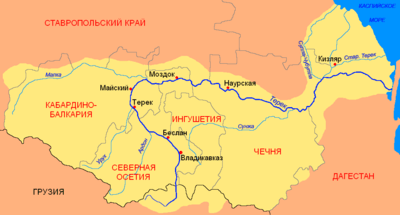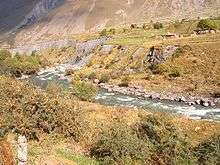Terek River
| Terek River | |
|---|---|
 Map of Terek river | |
| Country | Georgia; North Ossetia, Kabardino-Balkaria, Stavropol Krai, Chechnya and Dagestan, Russia |
| Basin | |
| Main source |
Mount Zilgakhokh, Caucasus Major, Georgia 5,037 m (16,526 ft) |
| River mouth |
Caspian Sea −28 m (−92 ft) 43°35′43″N 47°33′42″E / 43.595278°N 47.561667°ECoordinates: 43°35′43″N 47°33′42″E / 43.595278°N 47.561667°E |
| Basin size | 43,200 km2 (16,700 sq mi) |
| Physical characteristics | |
| Length | 623 km (387 mi) |
| Discharge |
|

.jpg)

The Terek River (Russian: Те́рек; IPA: [ˈtʲerʲɪk]; Karachay-Balkar: Терк, Terk; Georgian: თერგი, Tergi; Ossetian: Терк, Terk; Avar: Терек, Terek; Lezgian: Терек, Terek; Chechen: Теркa, Terka), a major river in the Northern Caucasus, flows through Georgia and Russia into the Caspian Sea. It rises in Georgia near the juncture of the Greater Caucasus Mountain Range and the Khokh Range, to the southwest of Mount Kazbek, winding north in a white torrent between the town of Stepantsminda and the village of Gergeti toward the Russian region North Ossetia and the city of Vladikavkaz. It turns east to flow through Chechnya and Dagestan before dividing into two branches which empty into the Caspian Sea. Below the city of Kizlyar it forms a swampy river delta around 100 kilometres (62 mi) wide. The river is a key natural asset in the region, providing irrigation and hydroelectric power in its upper reaches.
The main cities on the Terek include Vladikavkaz, Mozdok, and Kizlyar. Several minor hydroelectric power stations dam the Terek: Dzau electrostation (in Vladikavkaz), Bekanskaya and Pavlodolskaya.
Construction has started of the Dariali Hydropower Plant, with a planned installed capacity of 108 MW, on the territory of Kazbegi municipality near the Russia–Georgia border.[1]
Leo Tolstoy's novel The Cossacks is set on the Terek and amongst its Cossacks.
Tributaries
The Terek drains most of the northeast Caucasus east into the Caspian just as its sister, the Kuban River, drains the northwest Caucasus west into the Black Sea. Its major tributaries are the following. In the west a fan of rivers flows east and northeast into the Terek. These are the east-flowing Malka River, the Baksan River, the Chergem River and the Cherek River with its two branches. These three join the Malka just before it reaches the Terek. The Liashen, Urukh River, Duradur and Duradon flow northeast, the Ardon River and its branch, the Fiagdon River flow north and the Gizeldon River drains the north slope of Mount Kazbek and reaches the Ardon near its mouth. Then there is the north-flowing part of the Terek with the Darial Pass. The great northwest bend of the Terek is cut off by the northeast-flowing Sunzha River which catches most of the north-flowing rivers. These are the north-flowing upper Sunzha, the Assa River, the Argun and Khukhulau. East of these are the Aksay River and the Aktash River which formerly dried up in the lowlands between the Sulak and the Terek. In the east the Sulak River drains most of interior Dagestan and turns east to the Caspian before it reaches the Terek.
Human history
The capital of Khazaria, Samandar, may have stood on the banks of the river Terek.
The Terek river was the site of the final defeat of the army of Hulagu, khan of the Ilkhanate, at the hands of the army of Berke, khan of the Golden Horde, led by Berke's nephew, Nogai Khan, in the first civil war of the Mongol Empire, the Berke–Hulagu war of 1262. Also on the river Timur defeated Tokhtamysh in 1395.
The Terek Cossack Host (1577–1832 and 1860– ) had its base in the Terek basin. During the Russian conquest of the Caucasus it was part of the North Caucasus Line.
During World War II, German forces at the end of August 1942 reached the Terek near Mozdok – the farthest extent of German conquests in the Soviet Union – but aside from a small bridgehead were unable to forge further toward the oil fields of Baku, Hitler's objective.[2]
References
- ↑ Dariali Hydro Power Plant Construction and Operation Project (Environmental and Social Impact Assessment Reportt). Darial Energy LLC. Issued in 2011. Retrieved on 2014-16-07.
- ↑ Schramm, Percy Ernst (1963). Kriegstagebuch des Oberkommandos der Wehrmacht, 1940–1945 Teilband II. Bonn: Bernard & Graefe Verlag für Wehrwesen, p.583.